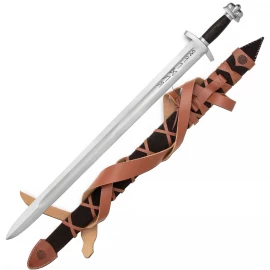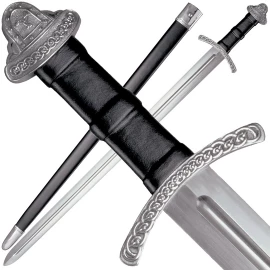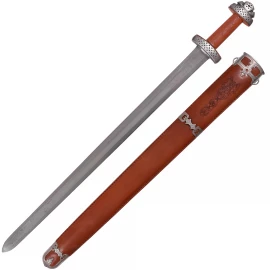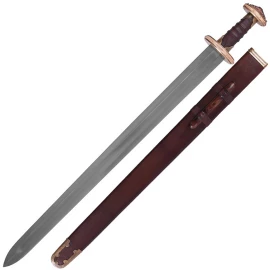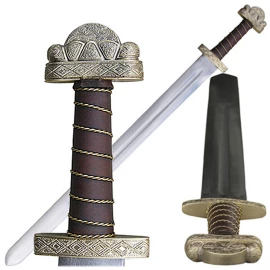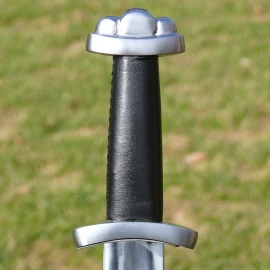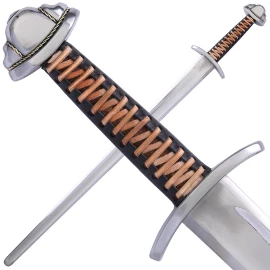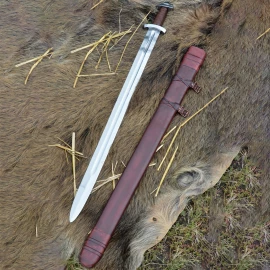Anglo-Saxon Fetter Lane Sword, 8th c., Damascus Steel
This gorgeous one-handed Saxon sword is based on the surviving components of an original artefact - the upper part of a sword grip and pommel excavated during construction works on Fetter Lane, London (hence the name), and donated to the British Museum in 1893. The extremely well-preserved, beautifully detailed original find made of gilded silver is an absolutely unique piece of Middle Anglo-Saxon history, still on display at the British Museum in London today. Owing to its construction, shape and intricate ornamental motifs, this finely crafted masterpiece is historically placed in the late 8th century and believed to have been the prestige weapon of a wealthy warrior or nobleman of Germanic descent. More information...
Notify me when the item is in stock.
We will inform you as soon as we stock up.
Anglo-Saxon Fetter Lane Sword, 8th c., Damascus Steel
As the blade of the actual archaeological piece is missing, a classic Dark Ages blade (broad, straight, double-edged) was chosen for this highly detailed Fetter Lane sword reconstruction. It is made of Damascus steel* and features a broad fuller that runs almost its entire length on both sides. The parallel edges are unsharpened. The richly decorated hilt is cast from brass. It is composed of several parts riveted together (just like the original) and closely recreates the fine designs of the museum piece. The pommel cap is made of a domed central element flanked by three smaller lobes and beaded wire patterns on each side. The pommel bar and the guard have both the same three-part layout and feature diagonal ribbing and an intermediate tin-plated brass layer. The grip is densely and intricately adorned with different motifs of intertwined leafy plants/tendrils and animals on either side (whirling serpents on one side and a bird- or eagle-like creature on the other).
This early medieval single-handed sword comes complete with a brown wood-and-leather scabbard with wooden suspension loop (max. belt width 5cm) and brass throat and chape.
Please note that this sword is not a battle ready weapon. It is designed as a collector's or decoration/display piece and is not suited for combat reenactment. Besides its quality as a collectible, it is also perfectly suited as a prop, e.g. to complete your costume.
A regular version of this sword with EN45 spring steel blade is also available in our shop (Product No. 0116041300).
Specifications:
- Material: Damascus steel blade (high carbon steel, not stainless), brass hilt with tin-plated accents
- Overall length: approx. 94cm
- Blade length: approx. 79cm
- Blade thickness: approx. 4.5mm (cutting edges approx. 1mm)
- Hilt length: approx. 15cm (grip approx. 8.5cm)
- Max. blade width: approx. 4.5cm
- Point of balance: approx. 13cm from the guard
- Incl. wooden scabbard with genuine leather cover, wooden suspension loop and brass fittings
- Weight without scabbard: approx. 1.65 kg
- Weight with scabbard: approx. 2.1 kg
Specs may slightly vary from piece to piece.
The steel used here is not rust-proof and might show slight surface tarnishing in places. We recommend you to maintain the blade and the scabbard on a regular basis, for example using Ballistol Universal Oil, which is ideally suited for steel care.
* The terms Damascus steel, damascene or pattern welded designate a compound steel forged out of two or more different types of steel. It is named after its birthplace, the Syrian city of Damascus, a former stronghold of the patterned steel production. As a common practice, a harder high carbon steel and a milder low carbon steel are repeatedly forge welded and folded together. The high carbon steel ensures a higher hardness, a better temperability and longer lasting edge retention, whereas the milder steel confers greater blade flexibility and tensile strength. This procedure, which arose in a time where steel qualities were often low and inconsistent, enables to combine the positive attributes of the various steel grades. Besides, the different shadings generated by the varying carbon content of the alternating layers engender strikingly beautiful patterns, such as the twisted motif called Torsion Damascus pattern or the Rose Damascus pattern. Undoubtedly, these unusual patterns partly explain why inherent magical properties were attributed to the Damascus steel blades of the Middle Ages.
We are here for you










